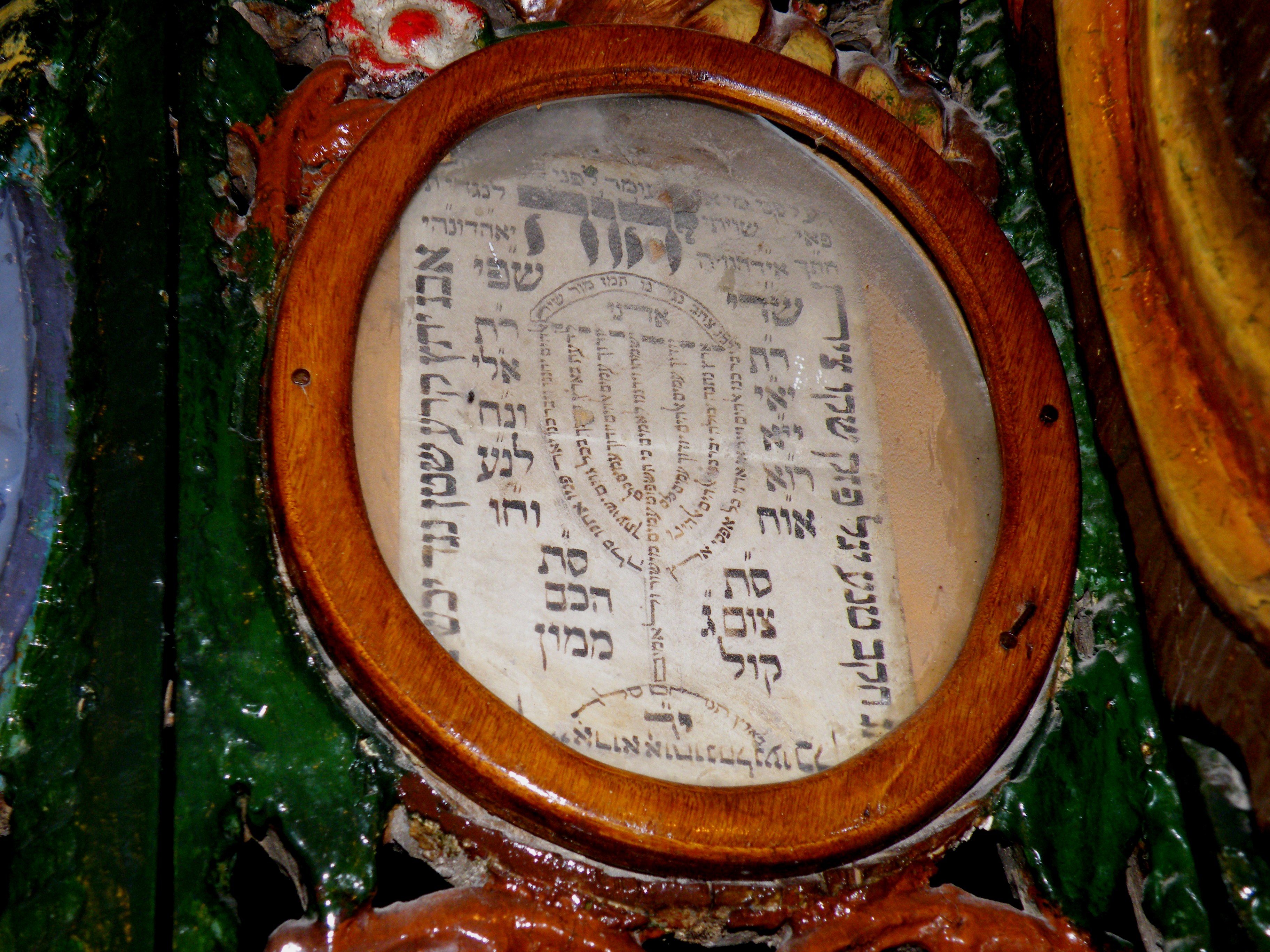I'm out on vacation and before leaving, I loaded my iPad with some new Torah apps that are really unbelievable.
The first is the new Artscroll Talmud app, complete with its classic English elucidation and really handy for keeping up with the daf yomi, which I hope to follow at least for Brachot (this study already brought me an idea for another post - in Brachot 6a the Talmud says that God also dons a pair of Tefillin, more on that soon).
The second is simpler but also handy - Chok L'Israel, a daily limmud of Chumash, Nach,Mishma,Talmud and Zohar very popular among the Sephardi communities. In my very first usage, i came across something I had been looking for a long time: the source for writing Sha-dai in the verse of the Mezuza. It's the Zohar brought in the first day of this week! I will quote the Hebrew translation because the original is quite difficult to understand:
זוהר ואתחנן דף רס''ו ע''א.בֹּא וּרְאֵה מִצַד שִׁפְחָה זוֹ יָצְאוּ כַּמָּה רוּחוֹת חוֹקְרֵי דִּין שֶׁמְּקַטְרְגִים כְּנֶגֶד יִשְׂרָאֵל, וּבָאִים לְקַטְרֵג עֲלֵיהֶם. וְהַקָּדוֹשׁ בָּרוּךְ הוּא עָשָׂה שְׁמִירָה לְיִשְׂרָאֵל כְּמוֹ אָב הָרוֹצֶה לִשְׁמֹר אֶת בְּנוֹ מִכָּל מִקְרֶה. אָמַר הַקָּדוֹשׁ בָּרוּךְ הוּא לְיִשְׂרָאֵל, כַּמָּה מְקַטְרְגִים מוּכָנִים כְּנֶגְדְּכֶם, עִסְקוּ בַּעֲבוֹדָתִי, וַאֲנִי אֶהֱיֶה שׁוֹמֵר אֶתְכֶם מִבַחוּץ. אַתֶּם תִּהְיוּ נְתוּנִים בְּבָתֵּיכֶם מִבִּפְנִים וְתִהְיוּ יְשֵׁנִים בְּמִטָּתְכֶם, וַאֲנִי אֶהֱיֶה שׁוֹמֵר עֲלֵיכֶם מִבַּחוּץ, וּמִסָּבִיב מִטּוֹתֵיכֶם. וּבֹא וּרְאֵה, בְּשָׁעָה שֶׁאֵלּוּ מִינִים הָרָעִים קְרֵבִים לְפִתְחוֹ שֶׁל אָדָם, נוֹשְׂאִים רֹאשָׁם וּמִסְתַּכְּלִים בְּהַשֵּׁם הַקָּדוֹשׁ הַנִּרְאֶה מִבַּחוּץ, שֶׁהוּא שַׁדַּי, שֵׁם הַזֶּה שׁוֹלֵט עַל כֻּלָּם, מִמֶּנּוּ יְרֵאִים וּבוֹרְחִים, וְאֵינָם קְרֵבִים לְפִתְחוֹ שֶׁל הָאָדָם. אָמַר לֵיהּ רַבִּי יִצְחָק: אִם כֵּן, יִרְשֹׁם הָאָדָם שֵׁם הַזֶּה, שַׁדַּי, בְּפֶתַח הַבַּיִת, וְלֹא יוֹתֵר, לָמָּה צְרִיכִים כָּל הַפָּרָשָׁה שֶׁבַּמְּזוּזָה, אָמַר לוֹ, יָפֶה הוּא, כִּי שֵׁם הַזֶּה, שַׁדַּי, אֵינוֹ מִתְעַטֵּר, אֶלָּא בְּאֵלּוּ הָאוֹתִיּוֹת כֻּלָּם הָרְשׁוּמִים בִּרְשִׁימַת הַמֶּלֶךְ, וּכְשֶׁנִּכְתֶּבֶת כָּל הַפָּרָשָׁה, אָז מִתְעַטֵּר שֵׁם הַזֶּה בְּעִטְּרוֹתָיו. וְהַמֶּלֶךְ, יוֹצֵא בְּכָל צִבְאוֹתָיו, כֻּלָּם רְשׁוּמִים בִּרְשִׁימַת הַמֶּלֶךְ, שֶׁהִיא הַמַּלְכוּת, אָז מְפַחֲדִים מִפָּנָיו, וּבוֹרְחִים מִפָּנָיו. בֹּא וּרְאֵה וְהָיָה, שֶׁל וְהָיָה אִם שָׁמוֹעַ, הוּא שֵׁם קָדוֹשׁ, הַוָּיָה, מִמַּטָּה לְמַעְלָה. כִּי כָּתוּב תְּחִלָּה ו''ה וְאַחַר כָּךְ י''ה. וְעַל כֵּן, נִרְשָׁם הַשֵּׁם שַׁדַּי מִבַּחוּץ כְּנֶגֶד הַשֵּׁם הַזֶּה. הַשֵּׁם וְהָיָ''ה מִבִּפְנִים, וְשַׁדַּי מִבַּחוּץ. כְּדֵי שֶׁיִּהְיֶה הָאָדָם נִשְׁמָר מִכָּל הַצְדָדִים מִבִּפְנִים וּמִבַּחוּץ
It seems clear from this Zohar that what really protects the house is not the Parshiot per se, but the word Sha-kai written upon the Parshiot. That's extremely interesting and it's evident from here that ommiting Sha-kai nullifies the protection.
But i would like to focus in another interesting point. The Zohar explains that Sha-kai must be written in the verse of the word Vehaia, because Vehaia can be re-arranged as the Tetragamon Name of God. My question is why not write it in the verse of the actual Tetragamon which is written so many times in the Mezuza?
Perhaps the answer is that the Sha-kai is written in the verse of the Mezuza parchment, and when looking in the verse you can see the words of the Parshiot reversed (because they are written in the other side of the parchement). Thus, it makes more sense to write Sha-kai over a word that is a "reversed" Shem, like Vehaia, because in that side of the parchement it resembles more the Shem if compared to the other standard Shemot.
Altenatively, I've seen that we writing Shakai in the verse of Vehaia is a kiyum of the pasuk יושב בסתר עליון בצל שדי יתלונן / He who dwells in the shelter of the Supreme shall abide in the shadow of Shakai. There was no further elucidation but my understanding is that בסתר here is an allusion to Vehaia, which is a hidden Name of God, and the pasuk says that this should be in the shadow of Shakai - in this case the pasuk makes perfect sense because you can see the shadow of Vehaia when writing Shakai on it!
I should mention that although Ashkenazim do follow this Zohar and write Shakai, they do so not in the verse of Vehaia but in the verse of the Parshiot gap which is right before he word Vehaia. The Rambam records this practice but I'm unsure why they - Ashkenazim and Rambam - don't follow the Zohar all the way.
Here's how its brought in the Shulchan Aruch:
בש"ע יו"ד (סי' רפ"ח סעיף ט"ו) כתב וז"ל: אסור להוסיף בה מאומה אלא שמבחוץ כותבין שדי כנגד תיבת והיה שבפנים. וכתב הרמ"א: ויש אומרים נגד הריווח שבין הפרשיות (טור בשם הרא"ש ועוד), וכן נוהגין. ומניתין נקב בקנה נגד שם שדי שיהא נראה מבחוץ












.jpg)













